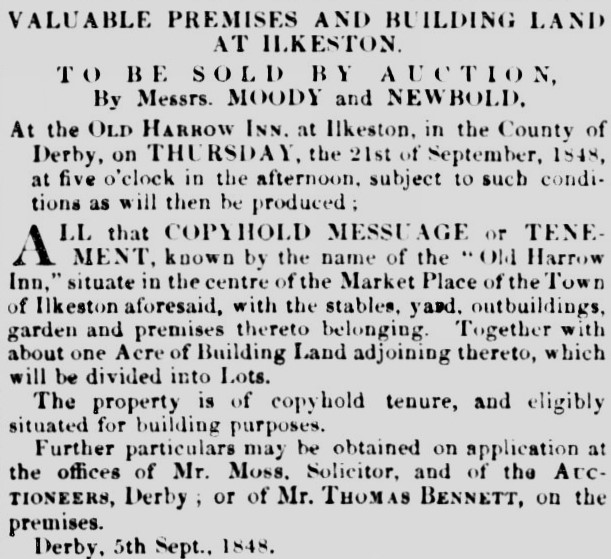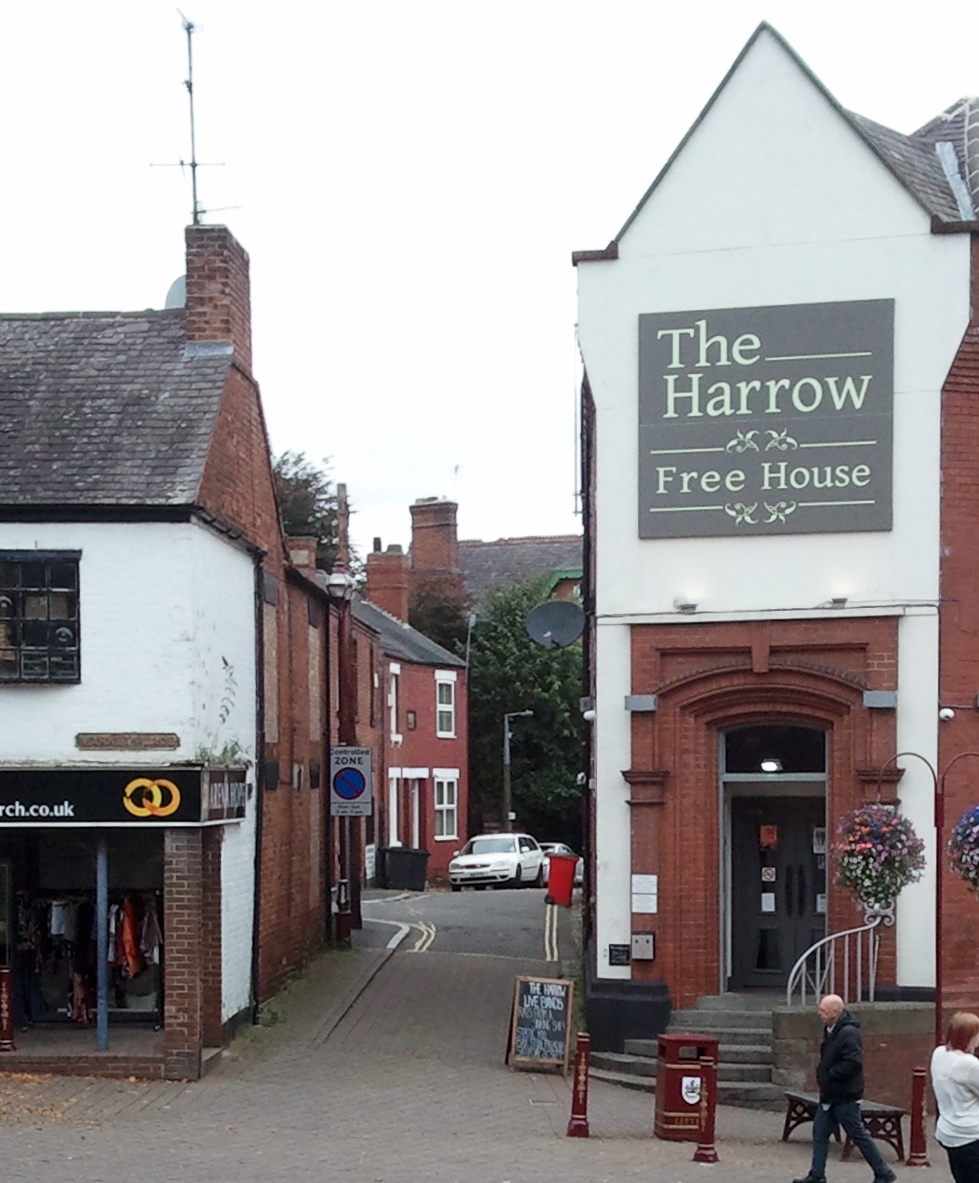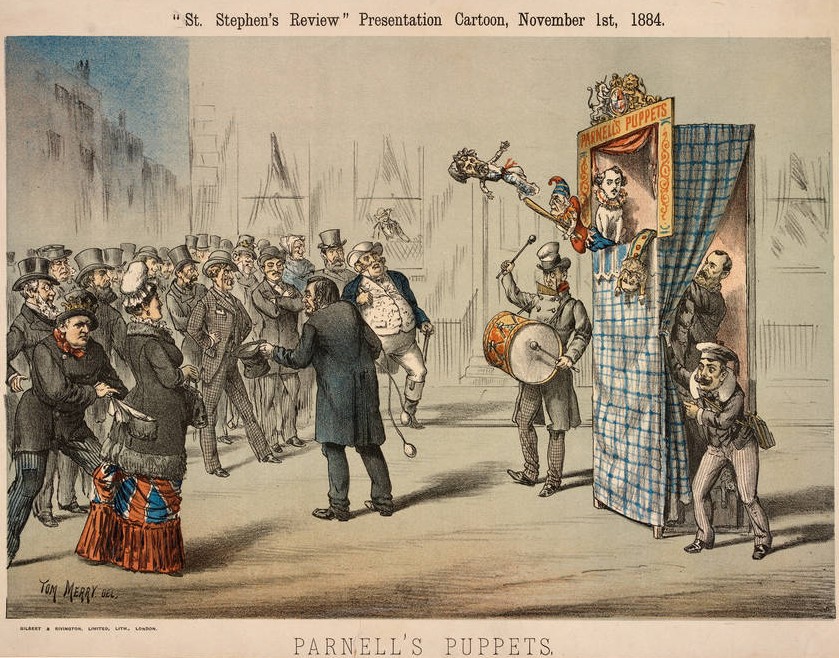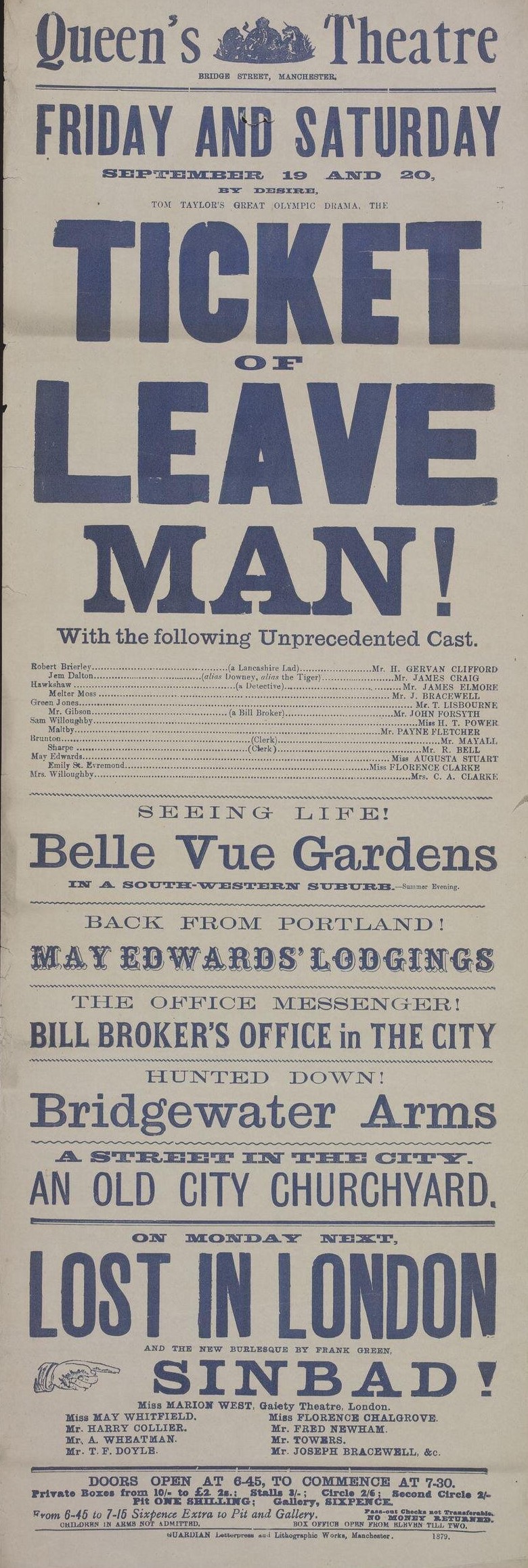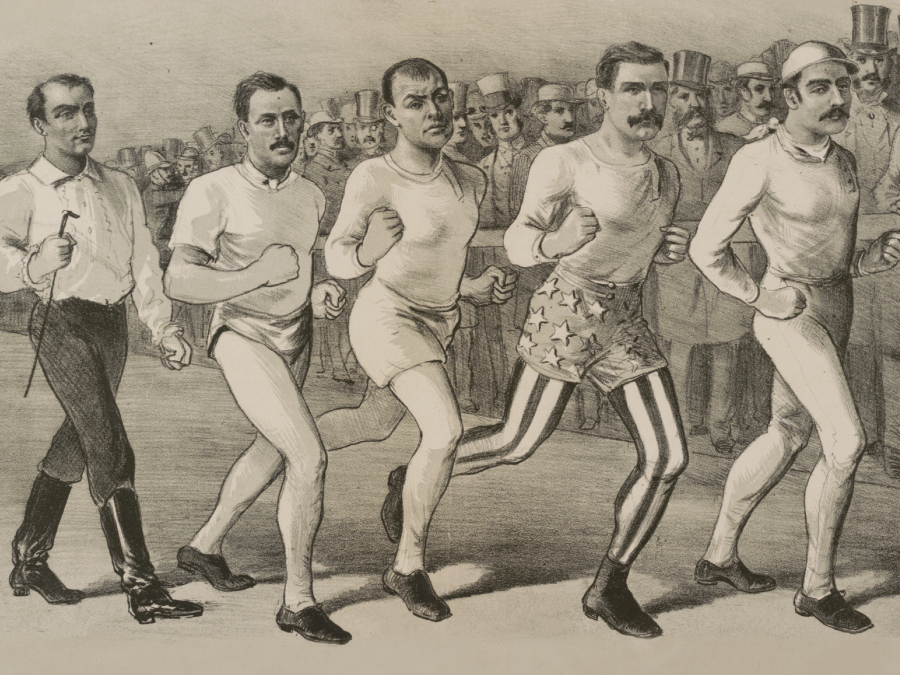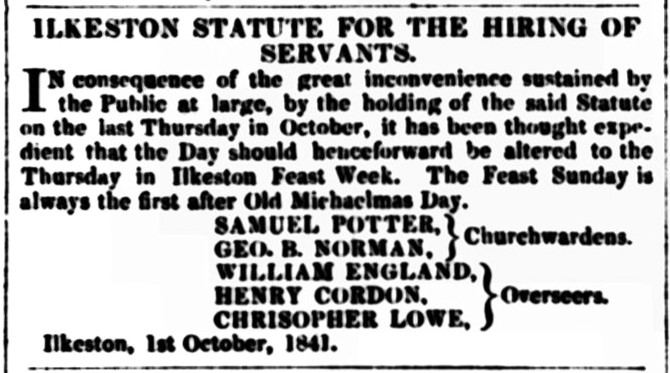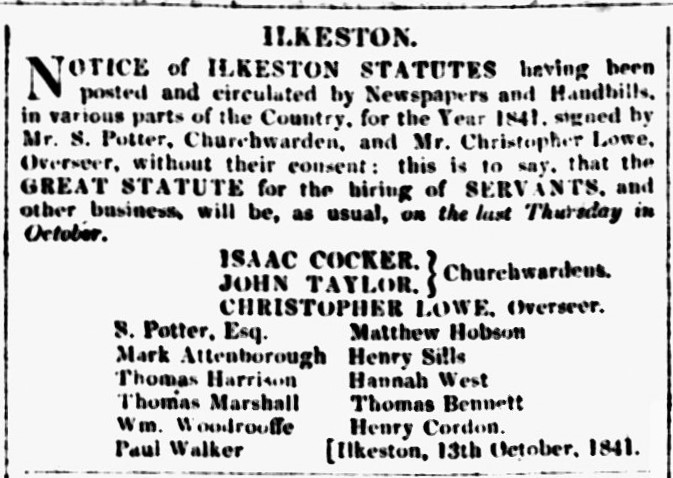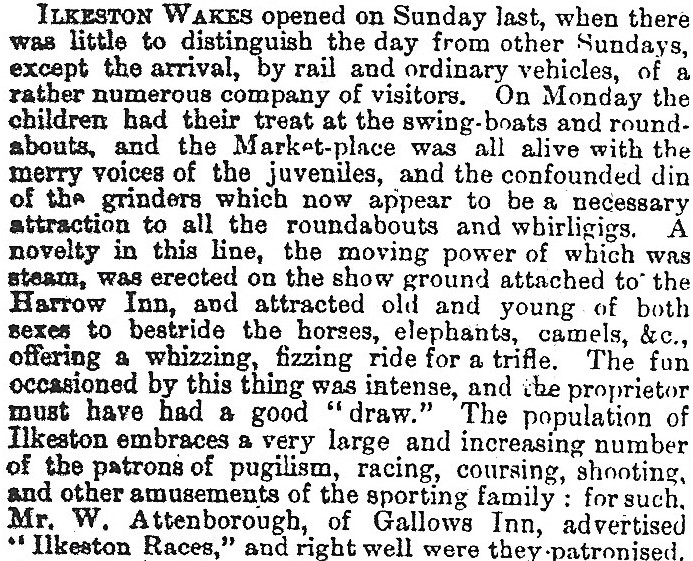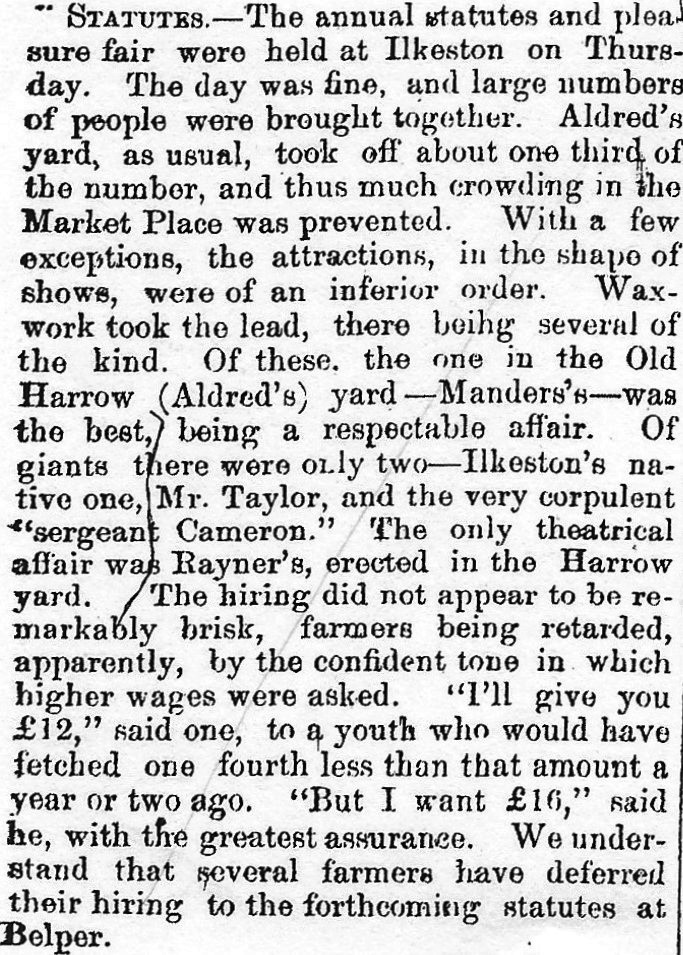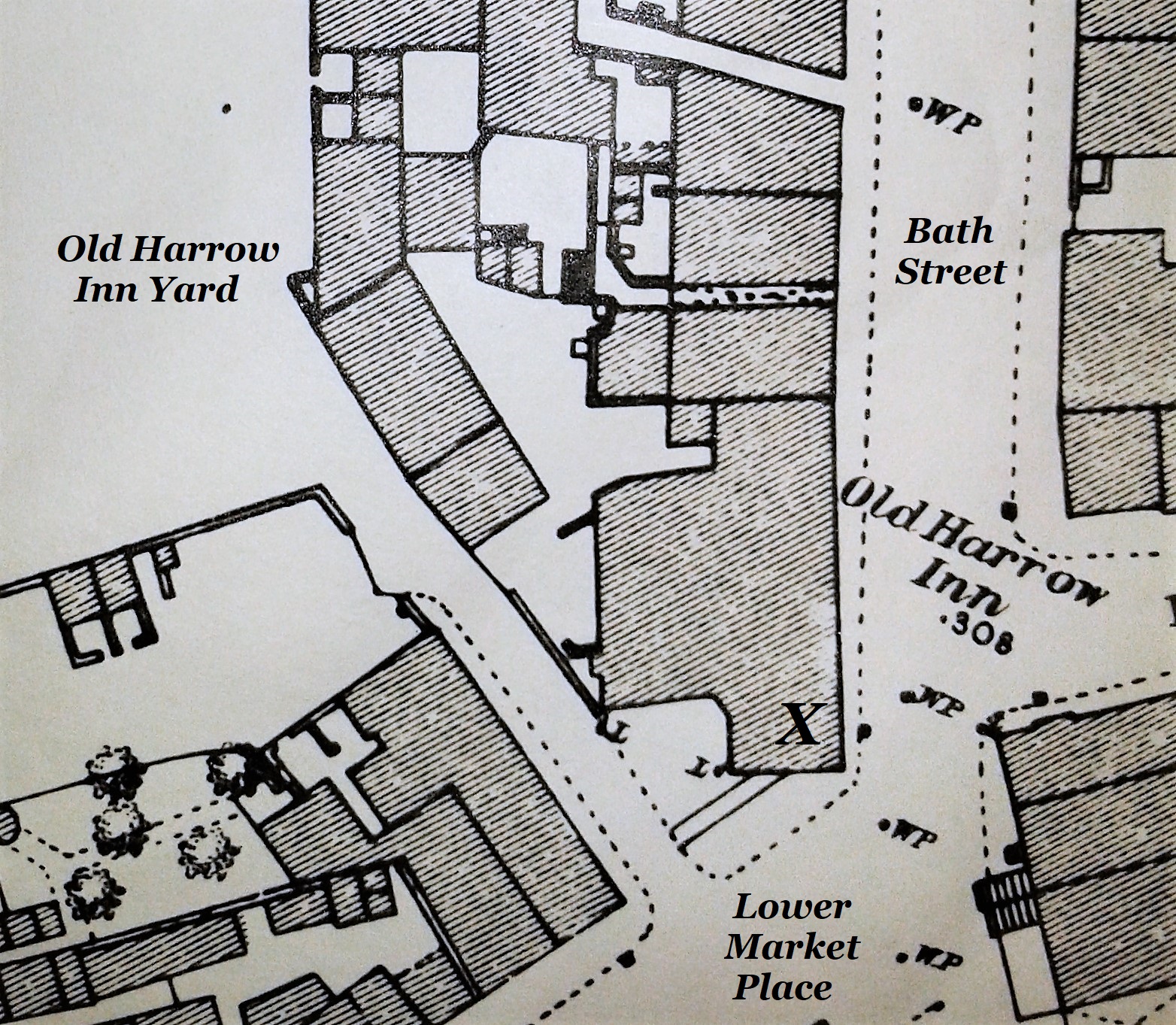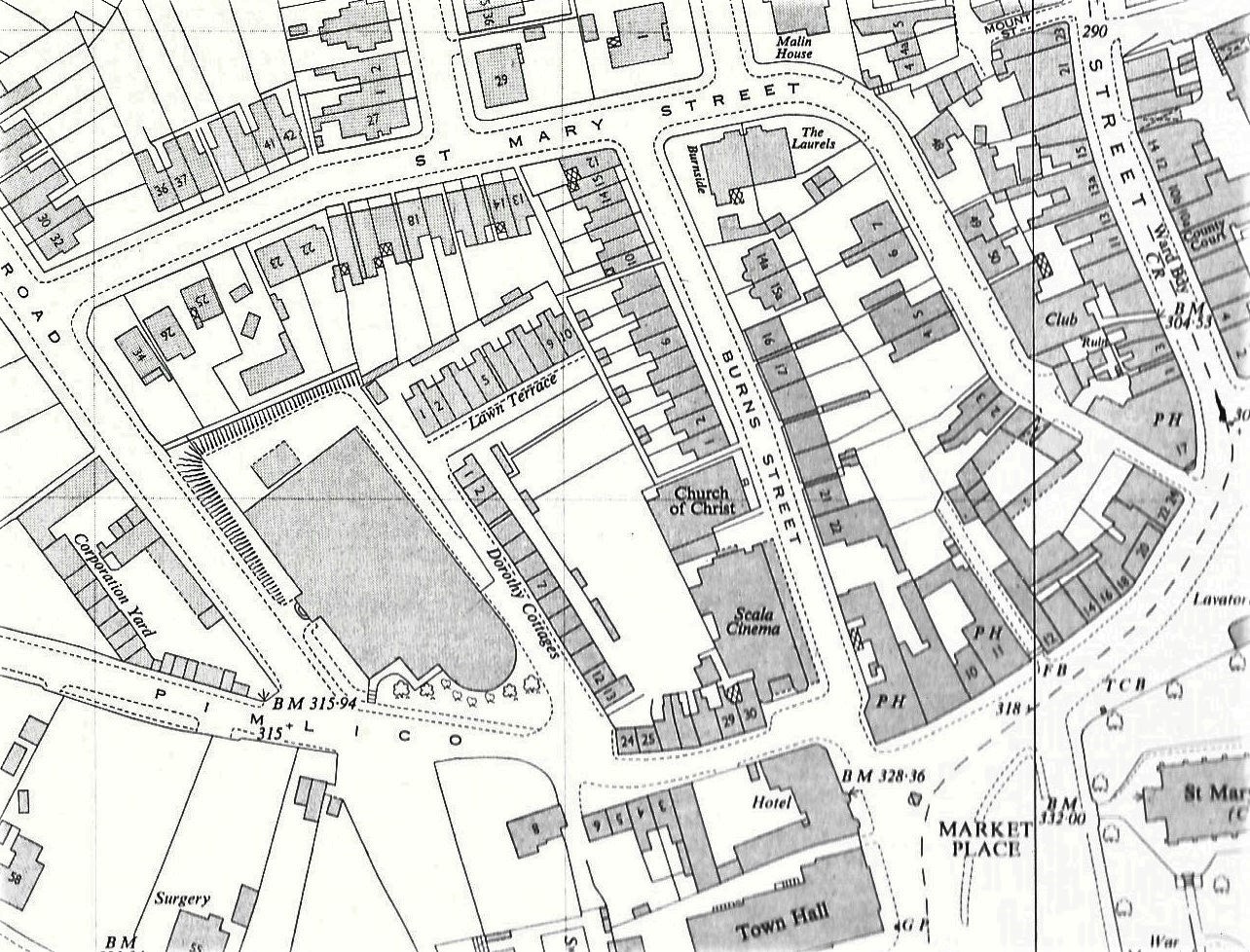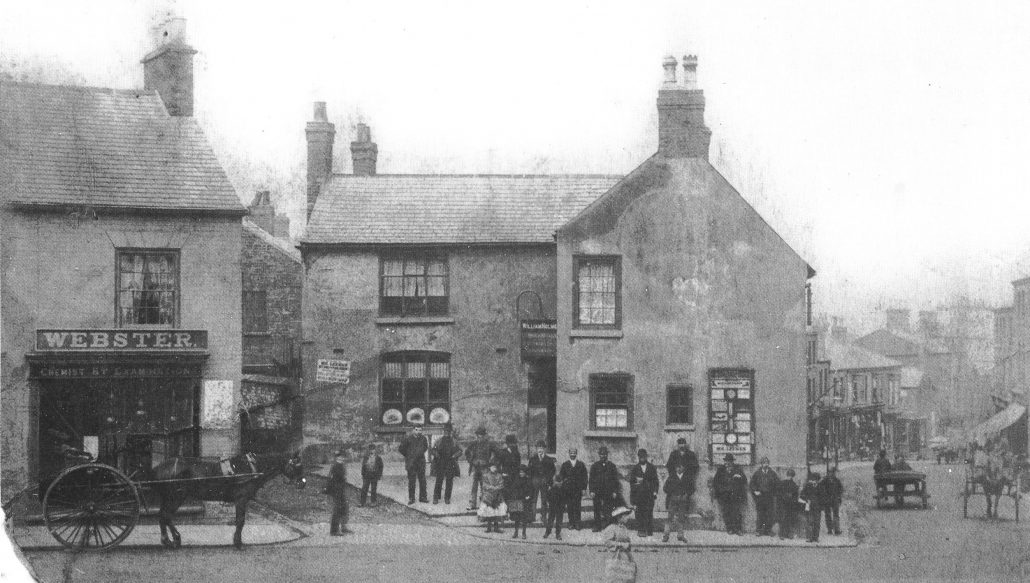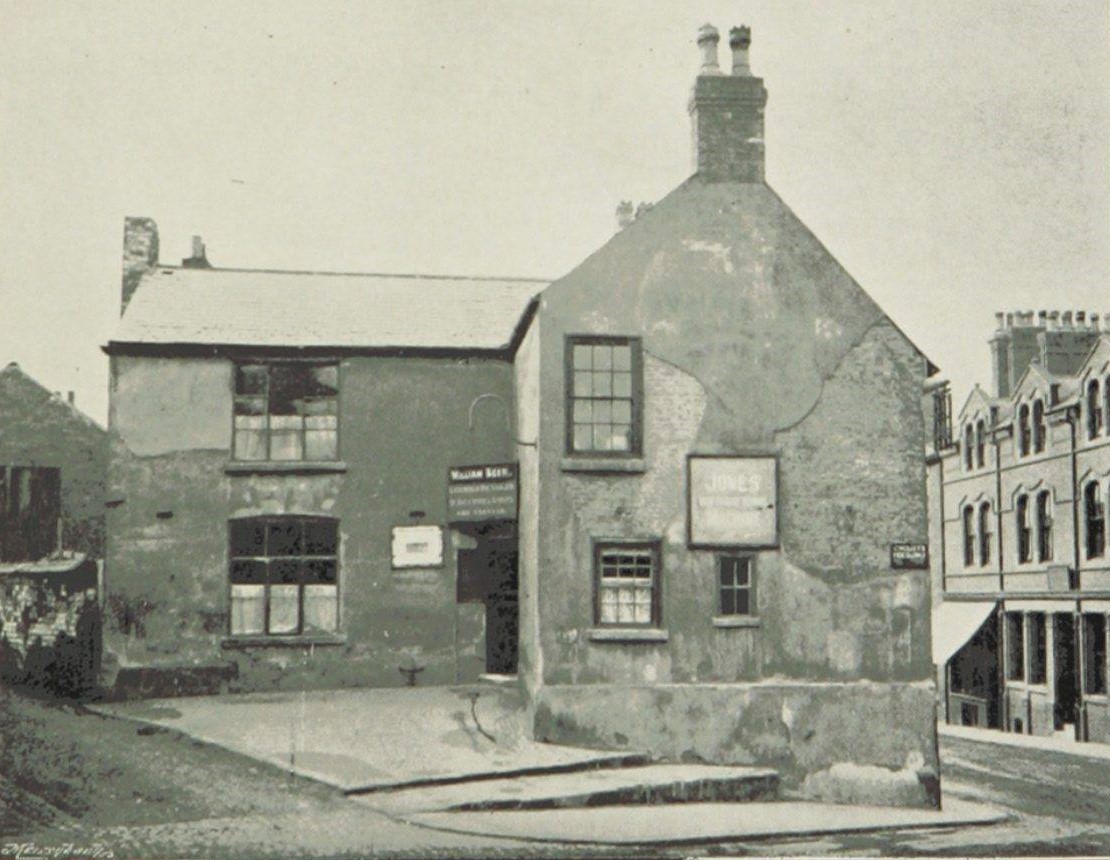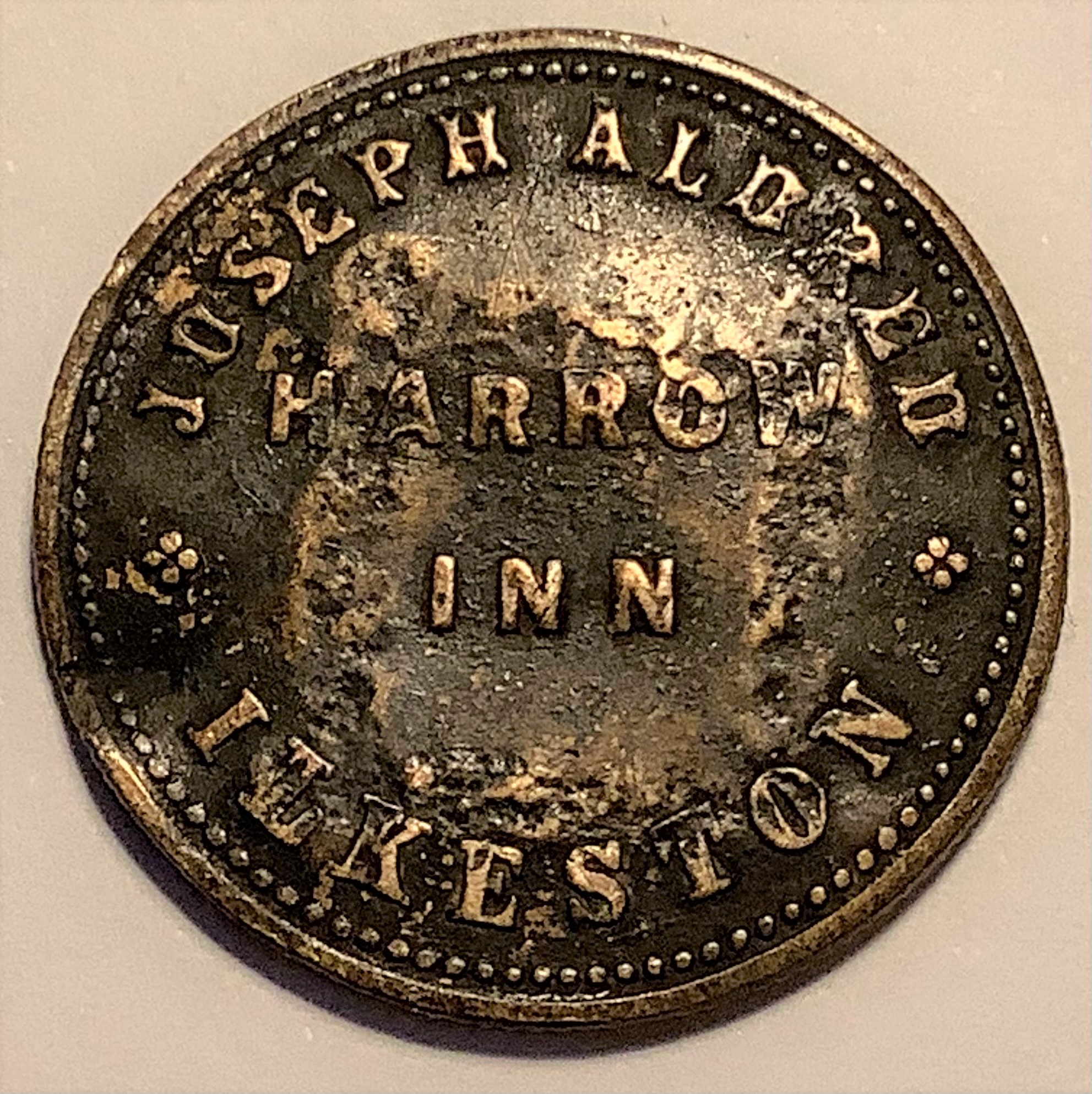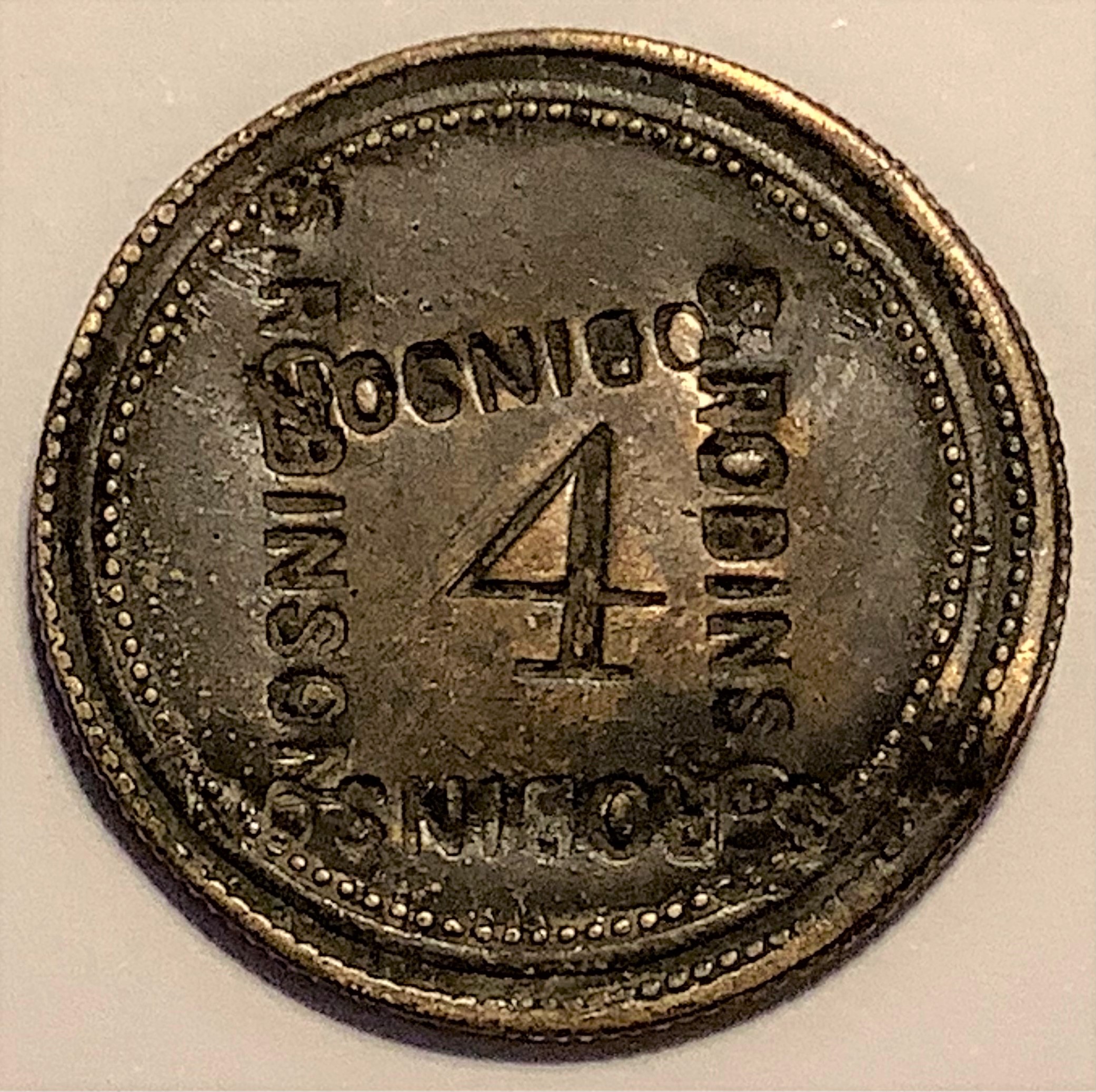What can we see?
Adeline writes that “on the west side of Bath Street was the Old Harrow Inn. (In the 1870’s and later this was at 14 Market Place.) At that time the only entrance to the inn was up the slight slope from the Market Place. The wall in Bath Street was a blank one. The old Harrow sign hung at the corner of the two streets, and the inn itself stretched further out into the roadway”.
Sheddie Kyme thought that the hostelry, with its colour-washed walls, and swinging sign on the corner, might be described as one of the most noted inns of the town. The reason for this may be the very prominent position which it occupied as you entered the market place from Bath Street.
And one person who would agree with Sheddie was landlord Joseph Aldred the Second (below) who, in 1857, was inspired to put pen to paper ….
In Ilkeston Town, if comfort would win,
Then seek you at once for the ‘Old Harrow’ Inn
Or, for the ‘Wine Vaults’ for solace is there,
To drive away sorrow, and banish dull care.
The ‘Harrow’ is useful, and profits doth yield,
Then come forth, ye toilers, from workshop and field;
And hypocrits heed not, nor bigots so narrow,
But come, as of yore, to the joyous ‘Old Harrow’,
And there find an anchor where sorrow shall cease,
For the ‘Old Harrow runs o’er a soil full of peace.
The liquors are good, and the profits are small,
And custom extensive is best for us all;
Then be it good Wine, Rum, Brandy or Ale,
Or the choisest Geneva, all’s here without fail !
At the ‘Old Harrow’ Inn, or the ‘Vaults’, you may find,
What suits every palate, and pocket, and mind;
As is speedily shown, and no flattery said,
For all will be proved by Joseph Aldred.
From the Ilkeston and Erewash Valley Almanack and Register of 1857, printed by John Wombell.
————————————————————————————————————————————————–
The Aldred Family
Joseph Aldred the Second (1822-1886)
Adeline points out that “the landlord of the Harrow Inn was Joseph Aldred. He had two sons, Joseph and Aaron”.
The landlord of the Old Harrow Inn from 1822 until the late 1840s was Thomas Bennett, who was there when the Inn was put up for auction in September 1848.
from the Derby Mercury (September 6th, 1848)
Thomas Bennett was followed by Thomas Marson in 1850. The latter was on hand in May 1850 to host the annual meeting of the Old Harrow Friendly Society, the oldest benevolent society in Ilkeston, being established almost 100 years previously.
However the landlord to whom Adeline refers (at the top) was Joseph Aldred the second, the younger son of Joseph the first and Amy (nee Knighton). Joseph the first was also a publican, for many years at the Rose and Crown in Cotmanhay. He was born in Horsley Woodhouse in 1787, the son of coalminer Robert and Ann (nee Fletcher).
Joseph the second left Cotmanhay in the late 1840’s to return to New Brinsley, his place of birth, where the 1851 census finds him as a licensed victualler and grocer, with his wife and two young sons, Robert, born in Ilkeston, and Joseph, born in Heanor.
In 1847 he had married Elizabeth Beard and returned to Ilkeston in the early 1850’s to trade at the Old Harrow Inn. With him and Elizabeth were two sons, Joseph and Samuel… there was no ‘Aaron’.
In 1872 auctioneer Frederick Paling — brother of Eliezer — was advertising the Inn for sale and described it thus …..
With wine vaults, four cellars and a brew house, it had a frontage to the Market Place of 35 feet and to Bath Street of over 101 feet, and with it was to be sold outbuildings and the large yard ‘from which is derived a good annual income from theatres, menageries, and other exhibitions’. There was a sizeable garden stocked with fruit trees, its own greenhouse, stables and piggeries, and a large well ‘with an inexhaustible supply of pure water’, always a very useful asset when brewing beer on the premises.
The Aldreds stayed at the Inn until Elizabeth died there in October 1875.
In June 1876 Joseph the second remarried to Jane Hardy, the widow of journeyman miller William Hardy and the daughter of shepherd Edmund Gascoyne and Mary (nee Brackenbury?), of Hougham, Lincolnshire.
Early in 1881 Joseph left behind Ilkeston and his old trade and headed for Ecclesall Bierlow, Sheffield, where he set up as a grocer. Joseph died there in April 1886, aged 64.
Joseph Aldred the Third (1850-1924)
In March 1876 the licence of the inn was transferred from Joseph the second to his son Joseph the third.
In February 1875 Joseph the third was looking at the new forge at Gallows Inn when sparks of red hot iron flew into one of his eyes and eventually caused blindness in both. Thankfully the affliction was temporary.
Leaving the inn a customer would pass through an inner door, along a short passage to an outer door and then down a steep series of steps. In June 1878 these steps were very poorly negotiated by butcher William Toplis — alias ‘Saturday’ — of Chapel Place off South Street (and brother of basket maker George), and as a consequence he broke his leg.
William claimed that he had been pushed through the doors and literally kicked out of the inn and down the steps by landlord Joseph Aldred. The latter argued that William was behaving in a disorderly fashion and he had simply ‘escorted’ him out of the door, tapping him upon his shoulder, politely opening the inner door to let him out. He had his slippers on at the time , so how could he kick William out??
Judge Woodforde at the County Court was very suspicious of Joseph’s evidence and was inclined to believe the butcher. But as there was no convincing proof of violent conduct he could not allow William’s £5 damages claim for injury and loss of ten weeks’ work.
Not to be out-done by local rival Captain Gregory at the Wine Vaults, Joseph opened a ‘splendid’ new billiard room at the Harrow Inn in August 1879.
Joseph was at the Old Harrow Inn until January 1881 when the premises were again put up for sale by auction, together with all its furniture, fixtures and trade utensils. Its premises, copyhold of the Manor of Ilkeston, were described as ‘commodious, including stabling, and necessary outhouses, a well laid out pleasure garden, and a very extensive yard’.
The inn was bought from the Trustee in liquidation by Charles Hiram Gregory, of the Wine Vaults, who paid £2880.
————————————————————————————————————————————————–
The Harrow Inn Yard attractions
The Inn’s spacious yard — now taken up largely by St Mary Street (above) — adjoined the house in the rear and here many activities took place and attractions appeared. In fact anything in those days was considered an attraction by the boys, from an auction van to a marionettes’ display.
Theatre and drama
————————————————————————————–
One such ‘lure for the lads’ was Tom Payne’s travelling theatre.
Its members would perform “modern” plays like ‘The Corsican Brothers’ (by Alexander Dumas 1845) and ‘The Colleen Bawn’ (a tale of love and intrigue by Dion Boucicault, 1860), as well as many old fashioned dramas like ‘Maria Martin, or the Murder in the Red Barn’, a melodrama based on the true story of the murder of a young girl in 1827.
Sheddie Kyme recalls ‘The Ticket-of-Leave Man’ by Tom Taylor (1863) and that venerable fossil ‘Ingomar’ (1851), a romantic drama by Austrian writer Friedrich Halm.
Dangling high in the ‘gods’ of the theatrical troupe’s temporary tented theatre, he and his mates would enthusiastically cheer that ‘beautiful sentiment’…
‘Two souls with but a single thought, two hearts that beat as one’.
Ilkeston had its own, real-life, ticket-of-leave man in the form of Thomas Garrett whom we shall meet later.
Games
Another attraction for the local lads was any opportunity to win a few ‘chance’ pennies.
For example, in October 1874 Tom Brooks brought his game of Two Pins to the yard and challenged the assembled group of juveniles to knock both pins down with one ball. A Penny a Go !! He persuaded several lads to try their luck and they obviously hadn’t realised that the pins were sufficiently far apart to make the task impossible.
When he was arrested for gaming he had seven or eight shillings on him – that is enough pennies for up to 96 ‘Goes’.
Tom spent the next month in jail.
Pedestrianism
Sheddie Kyme again:
“There was a time when the Old Harrow yard was notable for pedestrianism. Professional handicaps in Mr. Joseph Aldred’s day were very frequent and attracted many people. Some of the sprinters, I remember, in addition to Mr. John Tilson (alias Bellows), were some of the Eatons, including ‘Spanker’, who, I believe is now at Southwell, and William Spencer. Professionalism was more to the fore in those days, and much money would change hands in stakes on the various heats. I believe it was in this cinder track that Spencer first made his appearance as a sprinter, but he afterwards succeeded in securing one of the Sheffield handicaps, as many Ilkestonians will remember”.
‘Spanker’ was possibly twisthand Ezekiel Eaton, the son of framework knitter Edmund and Ann (nee Winfield) whom we shall meet in Extension Street. Ezekiel left Ilkeston with his family in the later 1890’s to work in Southwell.
And from the Nottinghamshire Guardian, August 1876, under the heading ‘Pedestrianism at Ilkeston’.
“On Monday a walking match took place at Mr. J. Aldred’s Recreation Ground, Market-place, Ilkeston, in which Frank Bradley (Perkins’ novice), of Nottingham, undertook to walk fourteen miles in two hours. The ground measured was 200 yards round, and 122 laps were required to make up the fourteen miles.
“Bradley started at 6.53 p.m. and completed the first seven miles at 7.49¾, or 3¼ minutes under the hour. He continued walking at a good pace, but when he had completed 31 laps of the remaining 7 miles it was almost dark, and as he complained of his feet being sore he was persuaded to relinquish the task at 8.23 p.m., having completed 10 miles 911 yards in one hour and a half. When he had eleven laps of the first seven miles to walk George Williams, of Ilkeston, started to walk seven miles with him, and continued after Bradley left the ground, our parcel being despatched before the result was known.
“On Saturday evening last Bradley undertook to walk 7¼ miles in one hour for a bet of £25, which he managed to complete with one minute to spare”.
The Wakes and Statutes
Confusion ? in 1841, both snippets from the Nottingham Journal and General Advertiser
And of course, we should not forget Ilkeston Wakes, occurring every year at October time ….
Writing in the Ilkeston Advertiser (April 28th 1933) about Ilkeston 50 years before, Richard Benjamin Hithersay (RBH) dismissively and not entirely accurately wrote “Those who wanted music-halls, theatres, or ‘life’ as it is generally understood, had to go to Nottingham or Derby to gratify their aspirations. … In the town itself there was nothing to break the monotony beyond the annual Flower Show, the ‘Wakes’, and the ‘Statutes’ — functions which were ceratinly very lively, and which attracted many hundreds from the surrounding villages. Apart from these, the ‘outings’ associated with the various religious bodies and an occasional concert in the Town Hall constituted about all the recreation available for the Ilkestonian of 50 or 60 years ago”.
————————————————————————————————————————————————–
The Harrow Inn Corner Issue 1890-1899
As you climbed Bath Street to enter the Lower Market Place area, you encountered a very sharp corner jutting into the roadway … a sharp corner that could prove very dangerous for pedestrians and vehicles alike. (X marks the spot … on the map above)
Traffic warning. September 2nd 1873.
Aboard his horse and carriage, furniture dealer William Alfred Whitchurch of South Street ‘sped’ through the Lower Market Place and around the Harrow Inn corner into Bath Street. Unfortunately, in his way was a daughter of collier William Jeremiah Bestwick of Wheatley’s Row. Onlooker William Bostock shouted a warning to the child but it was too late. A wheel caught her, knocked her down and ran over her, and the carriage ‘sluthered’ to a halt several yards further on. Still alive but badly bruised and with one ear severely injured the child was carried home, where she was attended by Dr. Robert Wood.
A month later and William Alfred was sued at court. Witnesses, druggist William Merry and grocer Samuel Lowe, both considered that the defendant was driving furiously — at least ten miles an hour – though William Alfred described it as ‘a moderate pace’, stating that the girl had run out in front of him, that he tried to stop, and that it was purely an accident which nobody could have prevented.
For that unavoidable accident the dealer was ordered to pay £1 11s damages and costs.
Wheatley Row … Accident Zone ?: keep clear
This map (above) is dated 1959 but it does show Wheatley/Wheatley’s Row, part of which has by now been renamed as Dorothy Cottages. It is numbered 1 to 13, and 24 to 30, as at the end of the Victorian era. The Bestwicks lived at number 29 while their neighbours were the Wheatley family of number 30.
Just over 20 years after this accident to his daughter, and still living at Wheatley’s Row off Pimlico — on April 4th 1894 — William Jeremiah Bestwick, then a newsagent, suffered an accident himself. He fell out of the bedroom window of his home, broke his neck and died almost immediately. Previously a coalminer, Jeremiah had suffered from ‘collier’s asthma’ for 21 years and had for the last seven weeks been confined to his bed, a condition which brought on depression.
On the night of the newsagent’s death, his wife Sarah Ann (nee Tilson) had gone downstairs to prepare a cup of beef tea for her husband, leaving him apparently asleep. About to return upstairs she heard a noise outside; her daughter Lavinia went to the door to see her father lying in the street gutter. The pair brought him inside but Jeremiah died almost immediately. His heart disease and dropsy caused him to go frequently to the bedroom window to gasp fresh air by the open window, though unusually, this time he seems to have stood on a chair by the dressing table to access the opening. Was he leaning too far out the window ? Sarah Ann didn’t know. However further evidence was provided by neighbour Samuel Froggett … on the fateful night he had seen Jeremiah at his bedroom window, standing it appeared on a chair, struggling to pull the top sash down. The window stuck, and he leaned on it with his body to push it down. Suddenly it came down, all at once, causing the newsagent to overbalance and fall into the street.
“Although his illness rendered him delirious at times” and he had little use of his legs, Jeremiah had borne his infirmity patiently, and had never threatened to injure hmself.
At the inquest the Coroner was sufficiently satisfied to record a verdict of ‘accidentally killed‘.
Jeremiah’s next door neighbour at number 30, was retired master builder John Wheatley who, you might have thought, had learned something from his neighbour’s accident. If he had, it was short-lived lesson.
On July 23rd 1896 John got out his old, trusted, 30-stave ladder, propped it against the pear tree on the grass plot by his home at Wheatley Row, and went up to collect a basket of pears. He was standing at the very top of the ladder with one foot on a rotting tree branch, when the branch broke, causing John to fall to the ground — but not before cracking his back on another branch on his way down. Witnessing this was Jeremiah’s widow Sarah Ann, and John’s daughter Elizabeth Ellen Shawcross, both of whom got the injured ex-builder into his house. Although he was now 60 years old, John apparantly still felt very confident climbing to heights — “I’ve been up hgher buildings than this tree”.
After a visit from Dr. Wood, John was transported to the Ilkeston Hospital but didn’t rally there, and died on August 3rd.
John Wheatley (alias John Wilson Wheatley, the son of John and Eleanor (nee Wilson)) came from a long line of brickmakers/builders/masons who had lived in the Pimlico area for many years and after whom this collection of properties was named. (Had they built the properties ?). From 1887 to 1890 he had been landlord at the King’s Head but on New Year’s Day the licence was transferred to his son, John junior.
About nine months after the death of John senior, his estate was put up for auction. This included houses numbers 24-30 of Pimlico, the 13 houses of Wheatley Row, and the 10 houses in Lawn Terrace. As you will see in the map above these premises formed three sides of a rough rectangle. The area of building land which they enclosed was also in the auction. The whole lot sold for £3510 and was purchased by George Robert Dean, architect and surveyor of Wilton Place in April 1897.
——————————————————————————
In March 1881 the Old Harrow Inn’s licence was transferred from Joseph Aldred to its new owner and into the Inn moved Herbert Gregory, younger brother of Charles Hiram Gregory, to act as manager.
The Vaults under the Harrow were renovated and then offered coffee, sandwiches and other refreshments, every morning at 6 o’clock, under the management of barman Norman Straw.
At the beginning of 1882 the issue of “the Old Harrow Inn corner” raised its head … an issue which was to last for the next ten years !!
Writing in the Pioneer, ‘Rambler’ considered the architectural curiosity of the inn to be “an eyesore which has for generations disfigured the entrance to our Market-place, … a rendezvous for many an idle lounger whose filthy remarks have too often offended ears polite, … (and) a point of danger that has upset the equanimity of many an even-tempered but unlucky individual”. He rejoiced in the knowledge that it might now be removed.
Charles Hiram Gregory had offered to sell the land on which it stood to the Local Board. Would the offer be accepted ?
That was not a question which the Local Board members could answer easily !!
As usual there was much discussion within the group … how much of the corner should be bought? At what price?
In spring 1882 Charles offered ‘the Harrow corner’ to the Local Board for £253, at £11 per square yard, so that the entrance to the Market Place might be widened. But then Charles put the freehold property up for sale.
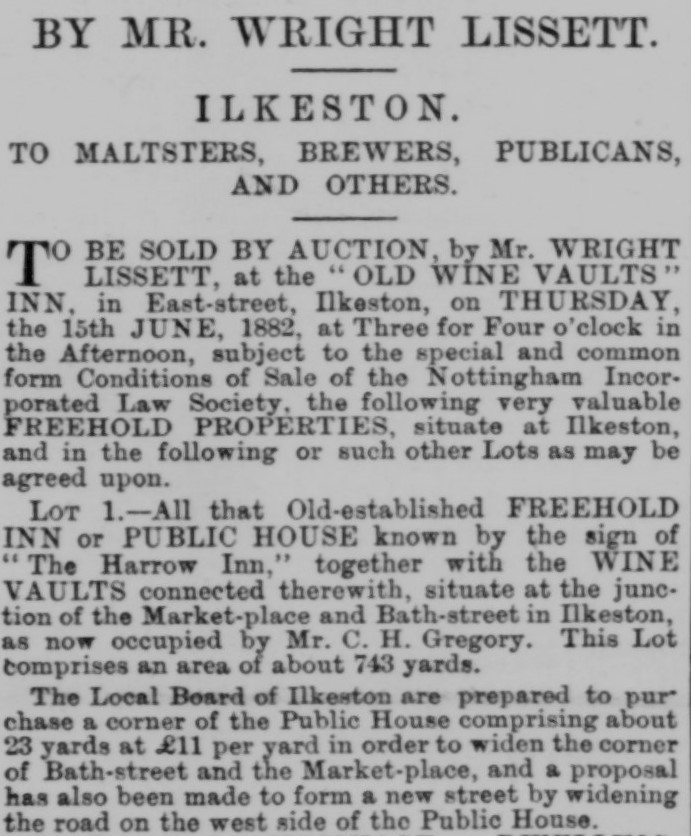 from the Alfreton Journal (June 2nd 1882)
from the Alfreton Journal (June 2nd 1882)
You will see within the advert, it is noted that the Local Board was negotiating to buy the “Corner”. In that June auction the inn was bought by Joseph Wheatcroft Small (son of George Small) for £3000, who moved from the Erewash Hotel in Langley Mill, Heanor. The latter hotel was taken over by William Parker.
Joseph Small died on September 17th, 1884, at the Inn, and his widow Emma (nee Sears) took over the licence for a short time. However in June of 1885 Emma remarried, to nurseryman and florist Charles John Frost, and moved out of Ilkeston( She died in 1888). The licence was then taken over by William Holmes.
The Old Harrow Inn c1887 (courtesy of the Ilkeston Reference Library)
The presence of an election poster for Samuel Leeke (Conservative) might indicate either the 1886 General Election or the 1887 By-election, both of which Samuel contested, unsuccessfully. Of course, someone may have forgotten to remove the poster, in which case the photo would show the inn post-1887. The name above the front door appears to be William Holmes (?) who, remember, was the landlord by 1885.
In late 1890 it was proposed by six members of the Council that the Old Harrow Inn be purchased “in order to widen Bath Street“. Negotiations began and soon a deposit of £350 was paid to secure the property. By April 1891, the Town Council had completed the purchase, for £3500. It was then resolved “that the landlord of the Inn (William Holmes) be allowed to continue as tenant of the premises at a rent of £140 per annum”, the tenancy to be terminated by a month’s notice in writing from either the tenant or landlord to the other.
Shortly after this the Inn was conveyed “to the Mayor, Aldermen and Burgesses of the Borough of Ilkeston” and then let to William Holmes at a rent of £140 per annum. William was still there on the 1891 Census when the Inn was number 17 Market Place.
The next step in the ‘Corner Saga’ would be to alter/demolish the Inn premises in order to widen the narrow Bath Street entrance into the Market Place. But not before Councillor Mitchell put forward a radical idea — a suggestion that the licence of these newly-acquired premises be allowed to lapse and the place be turned into a public library and reading room. The idea was not popular within the Council as it would lead to an increase in the rates to finance the library and even then, it might well prove too costly. Thus the motion was defeated.
The Council then decided to serve a notice to quit on William Holmes … he had to be out of the Inn by September 29th, 1891 … a decision which was not put into effect !! It looked like the Council was ready to begin demolition. However by November the Old Harrow had been once more let to William, at a rent of £140, on a monthly tenancy (which you can see was on the same terms as previously). Demolition would have to wait !!
Thus William was still at the Inn in January 1892 when he found himself in a spot of bother with the Town Council.
He was the owner of several newly-built or semi-built houses in Orchard Street and had allowed four of them to be tenanted without having obtained from the Council a certificate authorising them as fit for habitation. A bit of bureaucracy here — Number 26 on page 26 of the Town’s bye-laws stated that “no new house shall be occupied until the house drainage has been made and completed, nor until such house has been certified by the local authority, or their certified officer to give such certificate after examination, to be in evry respect fit for habitation, in his opinion”. The four houses failed on both counts — the drains were not completed and therefore the Borough Surveyor had refused a certificate. William was fined 20s plus costs.
Had the Council given up on the idea of sorting out this corner ? Was this the beginning of the end of the ‘Harrow Corner Issue‘ ? By the end of 1892 the Town Council still hadn’t made up its collective mind about what to do with the site it had purchased. No immediate plans had been drawn up therefore.
1892 saw renewed interest however … the Borough Surveyor drew up plans for the Old Harrow site, an architect was employed and another notice for poor William Holmes to quit was drawn up in 1893. However, still in the hands of the Corporation, the Inn was once more put up for auction on August 31st, 1893, together with the butcher’s shop and joiner’s shop which fronted Bath Street. Sadly for the seller the inn did not sell !!
In December 1893, William Beer replaced William Holmes as landlord (and at the same time his brother Severn Beer was moving into the Horse and Groom at Gallows Inn). And it was William Beer who applied for a transfer of a provisional full licence in August 1894. At that time the Old Harrow was still the property of Ilkeston Corporation but William wanted the licence for a new Inn which he hoped was going to be built in Station Road on land also owned by the Corporation. William’s application was supported by the Town Council (which was struggling with the problem of the Harrow Inn Corner), but it had outspoken opposition. The latter came in the form of the Temperance ‘party’ and the trustees of the Wesleyan chapel in Station Road, which had opened less than a year before, at the corner of Rupert Street. And there was also opposition from Sarah Ann Shaw, widow of Reuben, and her son-in-law James Cooke (married to Georgina Shaw) who had property interests in the Station Road area and who wished to develop their own licensed premises there … this was on the north side of Station Road, between Canal Street and the Erewash Canal. The premises had already been built and all they needed was a licence for it to operate as an ‘inn’ … it went by the name of ‘The Sea View’ and had cellars and kitchens in the basement, a smoke room, bar parlour, tap-room, club room and six bedrooms in the other storeys, and stabling for six horses. (The property is described in more detail here). Their application was supported by testimonials from the vicar of Holy Trinity Church (the Rev Binney), Edwin Trueman and a memorial signed by 324 local inhabitants. The area was growing rapidly and the last six years had seen over 200 houses built there with more being built close by. There was no full-licensed house within the whole of Station Road which numbered 155 premises, while adjoining streets brought that number up to 805.
In competition to the Shaw-Cooke application, William Beer’s application was for an adjoining property.
In time-honoured fashion, the Licensing authority expressed the opinion that no new licence was needed and therefore would not be granted. James Cooke’s application was thus rejected. And so too was William Beer’s request of a licence transfer for the Old Harrow Inn.
But the Town Council hadn’t given up .. and it was still trying to get rid of the Inn. At the end of February 1895 the Harrow was up for auction, together with a joiner’s shop over its carriage-house, and the adjoining butcher’s shop and shoe shop, fronting Bath Street. And there were special conditions attached to the sale. The buyer had to agree to pull down the existing building and rebuild it further back so that the roadway could be widened. Would anyone buy it ? Absolutely … it was bought by the Home Brewery Co. for £2620.
In July 1895 William Beer left the Inn, to be replaced by John Thomas Whitchurch, who had just left the Nottingham Castle pub in Cotmanhay Road. In March 1896 John Thomas left and Frederick Neaile became the landlord.
The widening of Bath Street at that corner seems to have been confirmed in 1896 at a projected cost of £1060. However it wasn’t until the Town Council meeting of July 1899 that it was announced the Local Government Board had sanctioned a loan of £880 (to be repaid over 50 years) for the improvements carried out at the Harrow Corner. This was at the same time as the “tramways scheme” had just passed through the House of Lords committee stages and was now on its way back to the House of Commons.
By 1899 Samuel Robinson had moved out of the Poplar Inn to take on the (New ?) Harrow Inn, still numbered 17.
————————————————————————————————————————————————–
And below is the Inn in the 1890s. The board above the door now shows the name of William Beer, landlord from about 1894.
From Trueman and Marston, published 1899.
Adeline conjectures — “I think that the Aldreds in Ilkeston came from one common stock, for another family of Aldreds had four sons named Isaac, Joseph, Aaron and Samuel”.
She may be referring to the family of collier Samuel and Mary (nee Ottewell) neither of whom she would have known in Ilkeston. However they had sons Isaac, Joseph, Aaron and Samuel, all of whom lived at one time in the town.
————————————————————————————————————————————————–
————————————————————————————————————————————————–
We continue our walk, going from the Inn towards the Town Hall and starting with the Harrow’s immediate neighbours.

